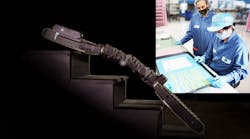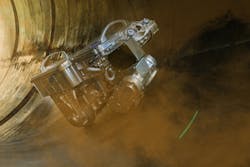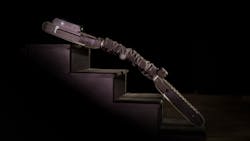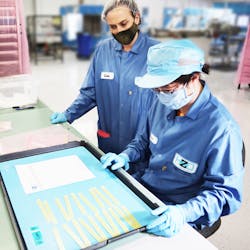At a Glance:
- Protective thin-film and nano coatings are being incorporated into the manufacturing process to improve the reliability of PCBs, integrated circuits (ICs) and macroscale assemblies.
- Parylene has become the protective coating of choice in robotics applications.
- Nano conformal coatings company HZO worked to deliver the ideal protection solution to robotic manufacturers by making Parylene a viable coating option.
Robots are purpose-built to help humans with productivity and cost savings while protecting them from dangerous and hazardous situations. Autonomous mobile robots (AMRs) are dexterous robotic systems that combine the intelligence, instinct and judgment of humans with the strength, endurance and precision of machines to help develop a safer and significantly more productive workforce than humans alone.
AMRs understand and move through environments without being directly overseen by an operator or on a fixed, predetermined path. They are uniquely capable of measuring and detecting variables beyond human perception and inspect hard-to-access areas with advanced speed and maneuverability.
They can navigate around fixed and variable obstructions and can perform tasks quickly and efficiently. They defuse bombs, traverse planets, inspect unstable structures and locate hard-to-reach assets in confined spaces. The big brother to automated guided vehicles (AGVs), which are remanded to rigid, preset routes, AMRs are able to locate the most efficient route to achieve each task and are designed to operate in collaboration with operators.
Integral to these modern marvels is their ability to gather and transmit data—long-range and real-time—a function requiring complex internal electronics. They range from discrete components (resistors, capacitors, transistors) to small-scale integrated circuits (op-amps, logic gates, motor controllers, timing chips) to large-scale integrated components (memory chips, digital RF receivers, coder/decoder circuits, communication protocol handlers) to full-blown microprocessors involving billions of transistors on a chip. Even complete computer systems are sometimes considered modular units for robotic systems.
Vital to their missions’ success is their continued functionality, yet their work environments could not be more hazardous to their electronic components. Robots rely on electrical circuits of varying complexity to control their parts, interacting with one other at certain levels. The probability of having electronics damaged due to a single event upset or cumulative effects of exposure to contaminants and unfavorable conditions are extraordinarily high.
Failure means retrieval, which has the potential to put humans in the environments in which the robot was designed to protect. Preventing contamination failure of printed circuit boards (PCBs) is a major requirement when considering assemblies’ potential exposure to all contaminants.
To maintain PCB and, therefore, robot functionality, protective thin-film and nano coatings are being incorporated into the manufacturing process to improve the reliability of PCBs, integrated circuits (ICs) and macroscale assemblies.
Thin-film conformal coatings have become the de facto coating of choice for electronics. Made of non-conductive dielectric materials, these protective coatings cover the entire board to protect component leads, solder joints, exposed traces and other metalized areas to increase the dielectric strength between traces and other metal conductors on the PCB.
They provide protection from corrosion and shields the entire PCB from spray, moisture, fungus, dust and other contaminations from harsh environments. Conformal coatings even help prevent damage from thermal and mechanical stress as well as rough handling, or in the case of AMRs, bumps and jarring during deployment.
Thin-film conformal coatings consist of a protective polymer layer 12-25 µm thick (<20 µm typical) that conforms to a PCB’s shape and components. They provide resistance to solvents and chemicals, are heat-resistant and help prevent delicate component leakage and corrosion. They are essential for PCBs that are going to be exposed to environments unfavorable to electronics.
Parylene has become the protective coating of choice for robotics’ challenging applications. Also known as Poly(p-xylylene), it is a protective polymer formed using a chemical vapor deposition (CVD) process, which creates a moisture and dielectric thin-film barrier. Parylene is considered by many to be the ultimate conformal coating and the protective coating of choice for challenging electronics.
The Parylene polymer series was isolated by the University of Manchester research chemist Michael Szwarc in 1947. In the 1970s, Union Carbide Corporation scientist William Gorham developed a deposition process to apply the film, the catalyst to commercializing the material and process. Although Parylene has been used for decades on a wide range of products, the high price of raw materials, scalability, manufacturing integration and device complexity were all factors limiting widespread and high-volume adoption.
Nano conformal coatings company HZO worked to deliver the ideal protection solution to robotic manufacturers by making Parylene a viable coating option. This goal was achieved by removing the most critical roadblocks of the material application by designing and deploying high-throughput coating equipment and automated processing systems for efficient manufacturing. The coatings company utilizes CVD to produce uniform and conformal coatings not possible with brushed, dipped or sprayed liquids applications.
HZO’s conformal coating process, from pre-production to post-production, is extremely thorough, leaving nothing to chance. After a planning stage to determine each robotics product’s protection needs, HZO assesses the manufacturing requirements—including masking considerations—and executes on the agreed-upon production plan.
Production occurs when units are loaded onto coating trays and placed into racks inside their custom-designed coating chambers where the coatings are applied. The large, cubed chambers hold hundreds of varying rack-loading configurations which facilitates scaling of hundreds, thousands or even millions of electrical components a day.
Parylene coating begins with raw material in powder form, added to a vaporizer and sublimed from a solid to a vapor. The chemicals are then heated to a just high enough temperature in a pyrolyzer, which “cracks” the raw material into an activated monomer.
At room temperature in the coating chamber, vapor forms a uniform, thin-film polymer barrier around the electrical components being coated. Because of its vapor form, the gas is able to penetrate layers deep, protecting areas not even visible in complex printed circuit board assemblies essential for the robotics industry.
The Parylene coating acts like a shield around the components creating an impenetrable barrier against moisture, corrosive gases and harsh chemicals from attacking the substrates. By safeguarding electronics with Parylene coatings, robots are able to withstand the tremendous challenges of repeated and extended exposures.
The high dielectric strength of Parylene prevents arcing and associated shorts; its thermal stability protects electronics in extreme environments, and the absolute conformal coverage provides the same level of protection to all areas of a component that’s free from air-gaps or voids.
Parylene in Practice
A case example of the efficacy of Parylene is Sarcos Robotics, a Salt Lake City-based manufacturer of industrial robotic systems that augment human performance by combining human intelligence, instinct and judgment with the strength, endurance and precision of machines to enhance employee safety and productivity.
The Sarcos snake-shaped Guardian S remote visual inspection and surveillance robot is a robust, multi-purpose, man-portable mobile IoT platform that carries multiple sensor payloads, providing real-time information while keeping the human operator out of harm’s way. The Guardian S robot is optimized for unstructured and unpredictable environments and designed explicitly to navigate uneven, challenging terrain and access small, confined spaces.
Built to go where humans couldn’t and shouldn’t, it inspects conditions of hard-to-reach assets in confined spaces to identify contaminants in unsafe, heavily polluted environments, detects chemical spills in manufacturing facilities, collects HAZMAT readings inside pipes and tanks, and other dangerous situations. The main function of the Guardian S is to save lives and prevent injury.
The engineering team at Sarcos kept that requirement in mind when considering printed circuit board assemblies’ potential exposure to liquid levels greater than two inches deep. Traditional mechanical seals were not reliable enough, and the traditional dispense solutions they explored did not deliver. The team also knew that HZO had the reputation and the chemistry to solve a variety of waterproofing and corrosion prevention problems.
HZO recommended Parylene coatings. They are extraordinarily thin, smooth, chemically inert and possesses dielectric properties—and can conform perfectly to a substrate because they adhere to it molecule by molecule. Sarcos sought to stretch Parylene protection boundaries for the Guardian S, so HZO took all the technical specs, conducted a range of rigorous experiments and increased the thickness of the Parylene to develop a superior protection bubble. To date, Sarcos has had zero product returns attributed to coating issues.
Lisa Rizzo joined HZO in May 2019 as a director of Product Management. She previously served in product management roles for Engineered Controls (RegO) and United Technologies. An advocate for improving diversity and inclusion of leadership in technology, she actively participates and mentors for Athena of the Triangle and the Wake Young Women's Leadership Academy.
Editor's Note: Machine Design's Women in Science and Engineering (WISE) hub compiles our coverage of gender representation issues affecting the engineering field, in addition to contributions from equity seeking groups and subject matter experts within various subdisciplines. Click here for more.




